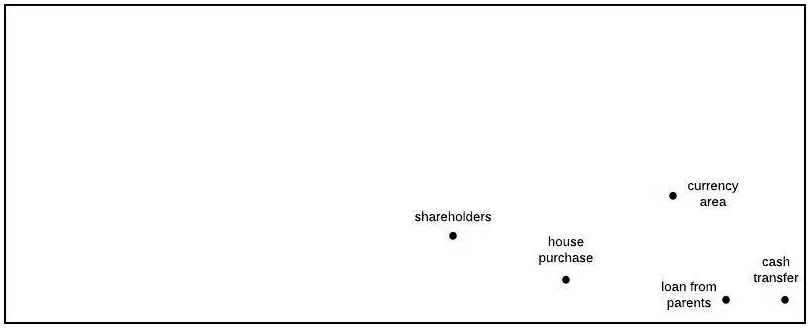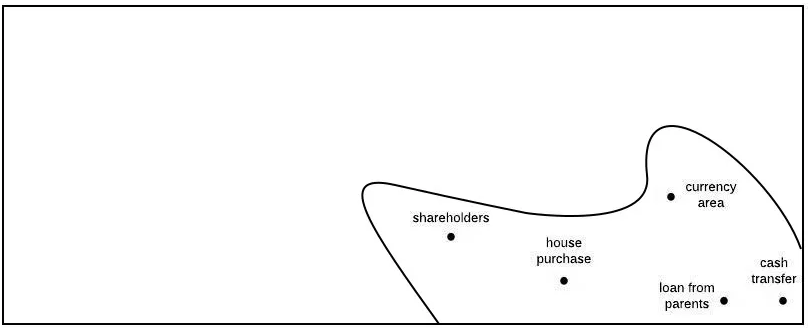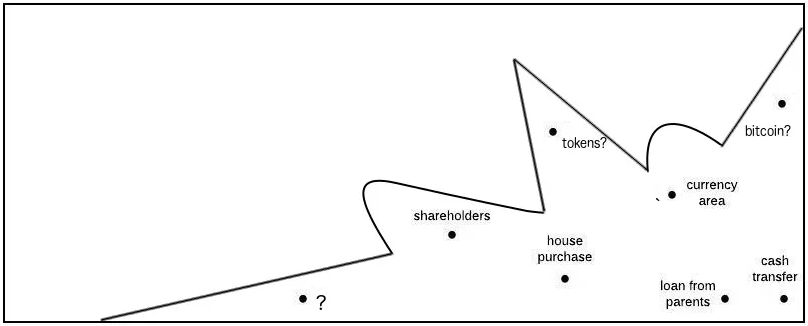👋 Note: Originally published on June 7, 2017 on a now-defunct personal blog.
A concept I often use to explain the potential of blockchain technology is “the space of possible economic relationships”.
What do I mean by economic relationships? I mean any situation where two or more persons enter into a relationship concerned with value:
- A transfer of cash
- An informal agreement to borrow money from a friend
- A legal contract to buy a house
- The relationship between all the shareholders of a corporation
- The relationship between all persons who use US dollars
This is meant to be very broad, including informal agreements, legal contracts, and very diffuse relationships that we don’t often think about, like sharing a national currency.
Now, let’s imagine a space that contains all possible economic relationships, and put some points on a graph.

This space includes not just all economic relationships that we’re familiar with or which are even used, but every possible economic relationship that could exist.
In reality, only some of this graph is available to us. Let’s draw a line to indicate which economic relationships are actually possible today.

Every economic relationship currently used by human beings (not just the ones we have highlighted as examples) is in this section. Every kind of purchase, corporate structure, debt instrument, store of value, and medium of exchange is somewhere inside that shape.
This shape used to look different, and was once much smaller. Until we invented money, we might have only had access to a very small area near the bottom right. Currency zones only became possible with stable political systems. Binding contracts required the slow evolution of complex legal systems. Public companies with shareholders required centuries of common law and commercial experience, and creating new specializations in professions like finance and law. All of these required technology, too: metalworking for money, writing for law, and even information technology for modern stock exchanges (ever heard of the paper crisis?).
We only have access to these economic relationships because these are the only ones for which we’ve built out the necessary institutions and technology. There are probably many other kinds of economic relationships out there, in the blank space, that we haven’t been able to access.
Recently, the invention of blockchain technology has expanded the frontier of this space. Now it probably looks a lot weirder — maybe something like this:

Blockchains let us do things that weren’t possible before:
- A small group of cryptography enthusiasts can successfully bootstrap a global currency into existence, without relying on the infrastructure of a nation state.
- We can now send money anywhere in the world very quickly and relatively cheaply, again without relying on traditional institutions.
- We can use very simple computer code to organize and collect millions of dollars from thousands of contributors all over the world.
Types of economic relationships that used to have big, expensive barriers to entry are suddenly a lot easier, and we’ve only really just begun experimenting with the technology.
Blockchains have expanded the space of possible economic relationships. But it’s been so sudden, we’re not really sure what to do with them yet. Usually these new capabilities develop slowly, because they require legal and political systems that are naturally gradual and expensive to change.
But blockchains let us do some things without those institutions, which means new capabilities become available much faster than usual. The limiting factor isn’t going to be whether we have the capability to do these things, but our ability to recognize that the space of possible economic relationships has expanded, and identify new useful things to build in those spaces.